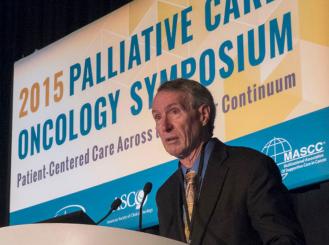Jan 26, 2016
The 2015 Palliative Care in Oncology Symposium fostered thoughtful discussion and new insights among faculty and attendees. As part of the ASCO Connection Clinical Conversations series, Symposium leadership have selected questions submitted during sessions by attendees via the electronic question-and-answer system (eQ&A) that could not be addressed in the time available onsite.
Daniel B. Hinshaw, MD, of the University of Michigan, and Timothy J. Moynihan, MD, of Mayo Clinic, co-chaired General Session 1: Improving Communication—Best Practices and Novel Tools. Other faculty included:
- James Tulsky, MD, Dana-Farber Cancer Institute
- Angelo Volandes, MD, MPH, Massachusetts General Hospital
- Areej El-Jawahri, MD, Massachusetts General Hospital
- Margaret Campbell, PhD, RN, FPCN, Wayne State University
- Paula Rauch, MD, Massachusetts General Hospital
- Kathi Mooney, PhD, RN, University of Utah
- Anthony Back, MD, Seattle Cancer Care Alliance
- Mary Jackson Scroggins, MA, Patient Advocate
In the following Q&A, Dr. Moynihan and Dr. El-Jawahri address some of the unanswered questions posed during the session.
How do we integrate decision aids with the need for physicians to make recommendations about whether (or not) CPR will help them achieve their goals?
TM: I think the decision aids cannot be used alone, and must be accompanied by rapid and real-time in-person feedback to answer questions. Also, given the physician’s expertise, it is incumbent upon physicians to make recommendations to the patients. (“Based on my experience with patients in a similar situation, I would recommend _______________. And the reasons I recommend this is ______________.”) The recommendations should be concrete, realistic, and readily understandable. In those rare conditions where there is obvious uncertainty, then exploring the patient’s preferences, listening carefully, and supporting the patient is the appropriate path.
Could Dr. El-Jawahri speak to follow-up after patients see the CPR video? Outside of the study, how do you envision it? Is it immediate? And by whom?
AEJ: Outside the study, I would envision that patients would watch the CPR video immediately before seeing their medical provider. In the context of cancer, they would watch the video prior to seeing their oncologist, in order to have informed discussions about the risks and benefits of CPR. For seriously ill patients who are hospitalized, we are hoping to conduct an implementation trial where the patients would watch the video within 24 to 48 hours of admission to the hospital followed by a discussion with their admitting physician.
TM: I envision the use of the decision aid as just that—an aid, not a replacement for detailed face-to-face discussion. The video could be used to set the stage for a detailed discussion, and should not be delayed for too long a period after viewing. What that period is I do not know, but I would prefer it to be at the same clinic visit.
Did you have any controls in your study to ensure that patients were not frightened into their decision making, that the video did not have a negative influence on declining end-of-life CPR?
AEJ: We were very careful to ensure that patients do not make emotive decisions. We asked patients if they felt comfortable watching the video and whether they found the video to be helpful. The overwhelming majority of patients (>90%) felt very comfortable watching the video and found it to be very helpful. Almost all patients would recommend the video to others facing similar decisions. These answers suggest that patients were not influenced by fear.
TM: As to the comment about “frightened into their decision making,” I would have to note that we know that the average person gets most of their medical information from the lay press, TV, movies, etc., and we are already fighting with the extraordinarily distorted vision of CPR and heroic measures that most of the public already see. So, I do not view this as “frightening” someone into a decision, but more providing what we know is a much more realistic picture of what really happens.
This is reflected in the fact that the lay public, when given a scenario, will opt for CPR in a setting of irreversible neurologic disease, whereas only 5% to 10% of physicians will opt for CPR in the same scenario. The physicians have done CPR and seen the negative outcomes. The public has only seen people on TV shows and movies get up and run out of the hospital after a cardiac arrest, as if nothing has happened. We as physicians know this is not the case and that our treatments can create more suffering, rather than relieve suffering.
More generally, how can it be assured that video, which is a one-way conversation medium, does not become an hindrance to patient-physician interaction? A quick “for instance” is that video will never be able to gauge patients' potential fear/anxiety at the information being delivered.
AEJ: We have actually found the opposite. Patients report having more conversations with their physicians about watching the video (we are about to publish these results as well). Videos facilitate a conversation between patients and physicians. The goal is not to replace a conversation, but promote conversations. There are multiple studies that have shown that decision aids can be helpful in engaging patients more in conversations with their doctors.
Read more 2015 Palliative Care in Oncology Clinical Conversations:

